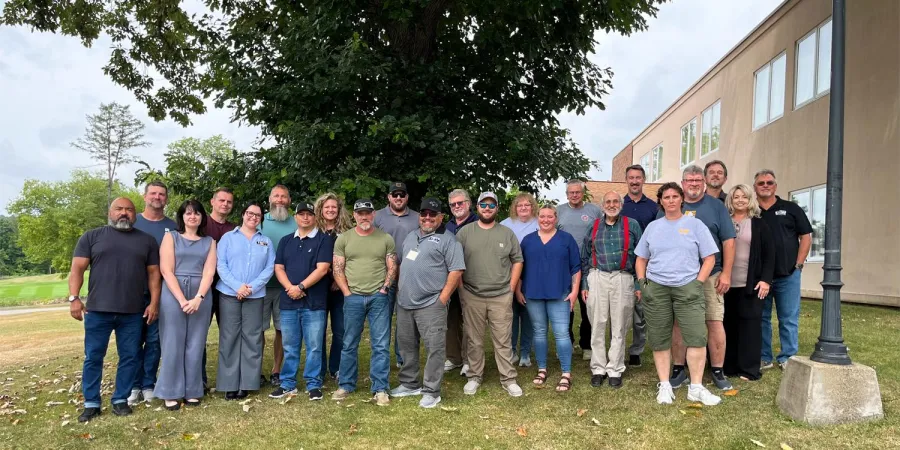Department of Energy safety representatives participate in specialized training

Seventeen USW DOE safety reps attended the USWTMC’s 2024 DOE Safety Rep training the week of July 22 at Linden Hall in Dawson, Pa.
Safety representatives (reps) wear multiple hats in the union and on site, and are vital to ensuring that workers are protected on the job and have a voice in workplace safety and health. Seventeen United Steelworkers (USW) Department of Energy (DOE) safety reps attended the USW Tony Mazzocchi Center (TMC)’s 2024 DOE Safety Rep training the week of July 22 at Linden Hall in Dawson, Pa. This year, the training reached more sites than the 2023 DOE Safety Rep training, as safety reps from the following sites were represented:
- Hanford Site (Hanford, Wash.)
- Idaho National Laboratories (Idaho Falls, Idaho)
- Paducah Site (Paducah, Ky.)
- Portsmouth Site (Portsmouth, Ohio)
- Waste Isolation Pilot Plant (Carlsbad, N.M.)
A large purpose of this annual training is to create a space for safety reps and advocates to gather and discuss issues present across the atomic sector, as well as learn possible solutions and recommendations from sites that have previously dealt with similar problems. Other key objectives of this training include:
- Enhancing technical and leadership skills of safety reps
- Equipping safety reps with beneficial tools and resources, both internal and external to the union
- Strategically planning for current and arising concerns, projects and changes across the nuclear complex
The training included a variety of discussions and exercises among participants. Monday morning began with introductions and an icebreaker to familiarize safety reps from different sites, encourage participants to engage with one another throughout the week, and facilitate a collaborative class environment. Class participants were then broken up into random groups to discuss safety and health issues at each site, obstacles that exist for improving safety and health and servicing the members, as well as changes that they want to see in the future across the complex and within the union. A major issue identified across the atomic sector is communication among various entities, including the union, workers, contractors and DOE. In addition, safety reps noted that job turnover, an aging workforce, a new generation of workers and lack of training across the complex are pressing issues among all sites in attendance. Other universal safety and health problems identified during the session include outdated equipment and procedural compliance. Class participants brainstormed potential solutions to alleviate the impacts of these problems across the complex. The day ended with a session to establish and describe the roles of health and safety reps in the workplace and the union.
Tuesday morning began with a leadership style activity to enhance the leadership skills among safety reps and facilitate a discussion on how to serve as an effective leader in safety and health. TMC staff then facilitated a communications mapping and problem-solving activity, followed by a session on committee structures. Lastly, sessions on assessing safety and health information and how to navigate difficult conversations among different parties were conducted. Safety reps were largely in their site groups for these activities so that they could simultaneously begin working through issues present on-site.
Additionally, a full day and a half was devoted to presentations by and discussions with guest speakers from DOE and former union officials, offering both historical perspectives and current opportunities. The presentations focused on two important topics for DOE workers:
- DOE’s safety and health offices and additional worker protections
- Compensation for energy employees
Marybeth Potter, a senior outreach specialist for Advanced Technologies and Laboratories (ATL) International Inc., spoke about National Institute for Occupational Safety and Health (NIOSH) dose reconstruction and the Special Exposure Cohort (SEC). NIOSH states that the SEC was established under the Energy Employees Occupational Illness Compensation Program Act (EEOCIPA) which provides compensation and medical benefits to eligible workers (or certain survivors if the worker is deceased) for illnesses related to exposure to radiation or other toxic substances while employed at DOE, its contractor or subcontractor facilities.¹ Claims compensated under the SEC do not have to go through the dose reconstruction process.² Kevin Dressman, the director of the Office of Health and Safety in DOE’s Office of Environment, Health, Safety and Security (EHSS), presented information on DOE’s Worker Safety and Health Framework, including materials on 10 CFR 851 and DOE’s Voluntary Protection Program (VPP). Richard Miller, former director of Labor Policy, United States House of Representatives member and former Oil, Chemical and Atomic Workers International Union (OCAW) activist, presented on DOE’s labor history, including reflections on the 40-year struggle to enact the EEOICPA and the DOE Former Worker Medical Screening Program. Lastly, Kevin Kilp, director of the Office of Environment, Safety and Health Assessments within the DOE’s Office of Enterprise Assessments (EA), presented on DOE’s Office of EA including their mission, the assessment process and how to navigate their website to find published assessments.
Following the guest speaker on Thursday, a short session on working with industrial hygienists and analyzing industrial hygiene reports was conducted. The week ended with a strategic planning session. For this session, safety reps met in their site groups to brainstorm strategies for tackling some of the safety and health issues they are currently dealing with in the workplace. Each site shared their strategic plan with the class.
Evaluations from the training were overwhelmingly positive, and TMC staff acquired multiple ideas for topics and activities to incorporate in the 2025 DOE Safety Rep training, including mapping lost-time accidents and HIPAA. The TMC strives to continue expanding DOE-specific training to workers across the complex. As a follow-up to the training, the TMC hopes to host more in-depth DOE-specific training sessions throughout the year that focus on topics such as 10 CFR 851 and other regulatory protections for DOE site workers.
For more pictures, visit: flickr.com/uswtmc.
References
¹ The Act/EEOICPA | NIOSH | CDC. (n.d.). https://www.cdc.gov/niosh/ocas/ocaseeoi.html
² Special Exposure Cohort (SEC) | NIOSH | CDC. (n.d.). https://www.cdc.gov/niosh/ocas/ocassec.html
Picture courtesy of Fiona Galley.